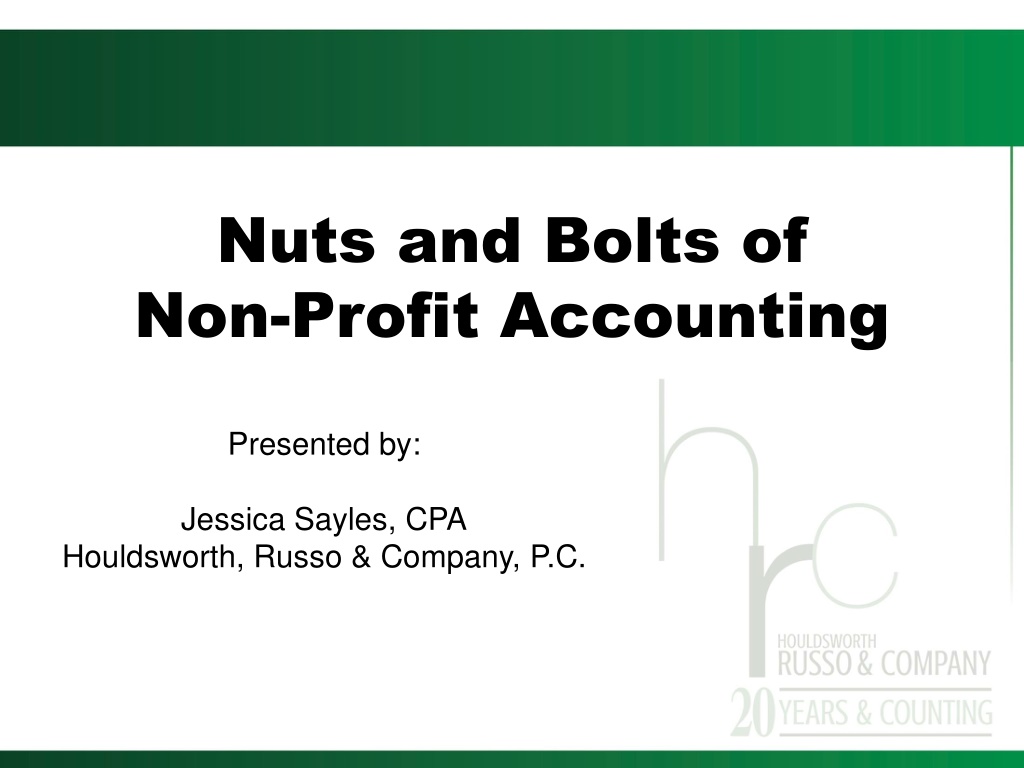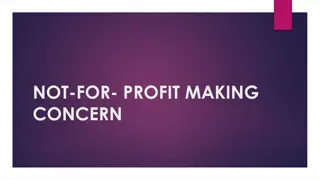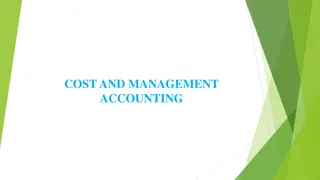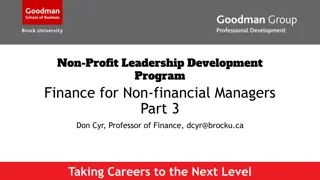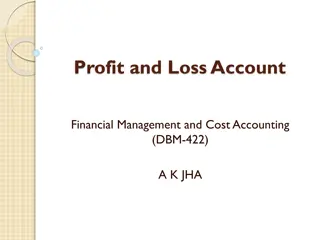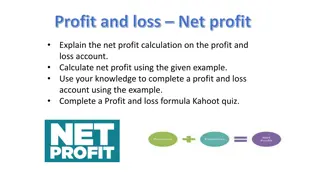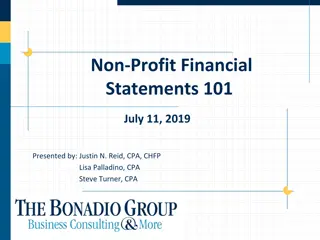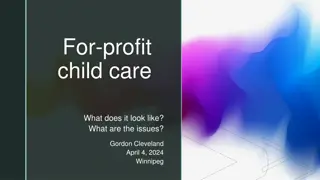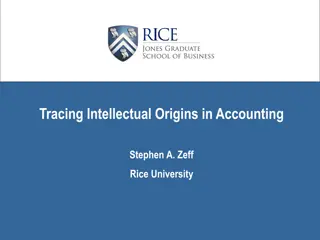Non-Profit Accounting Essentials
Learn the basics of non-profit accounting, including what defines a non-profit organization, common types of non-profits, governance structures, and legal responsibilities. Discover key insights on IRS and state requirements for non-profits in this informative presentation by Jessica Sayles, CPA from Houldsworth, Russo & Company, P.C.
Download Presentation

Please find below an Image/Link to download the presentation.
The content on the website is provided AS IS for your information and personal use only. It may not be sold, licensed, or shared on other websites without obtaining consent from the author.If you encounter any issues during the download, it is possible that the publisher has removed the file from their server.
You are allowed to download the files provided on this website for personal or commercial use, subject to the condition that they are used lawfully. All files are the property of their respective owners.
The content on the website is provided AS IS for your information and personal use only. It may not be sold, licensed, or shared on other websites without obtaining consent from the author.
E N D
Presentation Transcript
Nuts and Bolts of Non-Profit Accounting Presented by: Jessica Sayles, CPA Houldsworth, Russo & Company, P.C.
What is a Non-profit? A trust, corporation, or association must submit a Form 1023 to IRS to be awarded non-profit status. Except Churches and organizations with less than $5,000 gross receipts automatically exempt if requirements of section 501(c)(3) are met A non-profit is allowed to (and should) make a profit. 2
Common Types of Non-profits 501(c)(3): Religious, educational, charitable, etc. Examples: Opportunity Village, St. Jude s Ranch for Children, SAFE House, etc. 501(c)(6): Business leagues, Chambers of Commerce, etc. Examples: Henderson Chamber of Commerce, Nevada State Education Association, American Polygraph Association, etc. 3
Governance Board of Directors Legally responsible for the organization Strategic planning Approves annual budget Oversees the Executive Director Fundraising 4
Whos Looking? IRS State of Nevada General Public 5
IRS True or False? The Internal Revenue Code requires charities to have governance and management policies 6
IRS FALSE! The IRC does not have specific requirements, HOWEVER Form 990 Specific questions regarding governance include Conflict of interest policy Whistleblower policy Compensation policies Process for reviewing the Form 990 Size and composition of the board Relationships and independence of the board 7
State of Nevada True or False? Nevada law imposes upon directors of charities the fiduciary duties of care, loyalty and obedience to the law 8
State of Nevada TRUE Duty of Care Directors of Nevada must discharge their duties in good faith and in a manner in which the director reasonably believes to be the best interest of the organization. Active participation, Attending board meetings, involved and informed on financial information, recordkeeping, fundraising, minutes of board meetings Duty of Loyalty Directors must give their undivided loyalty to the nonprofit corporation Avoid conflicts of interest, establish written conflict of interest policies, cannot misuse corporate information Duty of Obedience Directors must obey the governing documents and comply with state and federal laws Know and meet filing requirements, seek outside help when necessary 9
State of Nevada True or False? A director may be held personally liable for injuries caused by the director s intentional misconduct, fraud, or knowing violation of the law? 10
State of Nevada TRUE If the director exercises due care in managing the nonprofit organization, the director is immune from liability Misappropriation of corporate information may subject the director to criminal liability The nonprofit organization itself may be held liable for negligent or wrongful acts of employees. In extreme cases, the organization may be dissolved 11
General Public True or False? The past 3 years of your Form 990 is open to inspection by the general public 12
General Public TRUE Your financial information, compensation of directors and officers, and governance policies are open and available to the public How do you want to look? 13
General Public Resources are available Panel on the Nonprofit sector issued the Principles for Good Governance and Ethical Practice: A Guide for Charities and Foundations 33 principles based around 4 main categories: legal compliance and public disclosure, effective governance, strong financial oversight, and responsible fundraising Independent Sector issued The Principles Workbook: Steering Your Board Toward Good Governance and Ethical Practice Companion to the Principles Guide Offers practical implementation of all 33 principles broken out into core concepts, discussion points, legal and compliance issues and resources 14
Resources Panel on the Nonprofit Sector www.nonprofitpanel.org The Principles Workbook: Steering your Board Toward Good Governance and Ethical Practice www.independentsector.org IRS.gov Charities and Non-Profits http://www.irs.gov/pub/irs- tege/governance_practices.pdf Nevada Department of Justice Guide to Nonprofits http://ag.nv.gov/uploadedFiles/agnvgov/Content/H ow_Do_I/NDOJ_Guide_to_Non-Profits.pdf 15
External CPA Engagements Compilations Reviews Audits Agreed Upon Procedures/Consulting Tax preparation 16
Reasons for Audits Report to grantors Requirement to receive a loan or part of a loan agreement Internal check-up of accounting controls and processes To receive larger contributions 17
Accounting Methods Accrual versus Cash Basis Accrual basis Generally accepted accounting principles (GAAP) Recognize revenues when earned Ex: You bill your grantor in July for expenses incurred (spent) in June. You receive the money in August. You should book a receivable and revenue in June. When the money is received, you would record cash in and reduce the receivable in August. Common receivables Accounts receivable Grants receivable Pledges receivable Recognize expenses when incurred Ex: You receive your January electric bill in February and pay it in February. Your should record a payable and electric expense in January when the expense was incurred (you utilized the services). When you pay the bill in February, you should record cash out and reduce the payable in February. Common payables Accounts payable Accrued expenses Deferred revenues 18
Accounting Methods Accrual versus Cash Basis Accrual basis Generally accepted accounting principles (GAAP) Recognize revenues when earned Ex: You bill your grantor in July for expenses incurred (spent) in June. You receive the money in August. You should book a receivable and revenue in June. When the money is received, you would record cash in and reduce the receivable in August. Common receivables Accounts receivable Grants receivable Pledges receivable Recognize expenses when incurred Ex: You receive your January electric bill in February and pay it in February. Your should record a payable and electric expense in January when the expense was incurred (you utilized the services). When you pay the bill in February, you should record cash out and reduce the payable in February. Common payables Accounts payable Accrued expenses Deferred revenues 19
Accounting Methods Fixed assets Assets that have useful life of one year or more and are over a certain threshold should be assets on the balance sheet instead of expenses on the income statement Determine the useful life of the asset and then depreciate it over that lifetime Ex: a purchase of a $1,200 computer might be spread over a 3-year period, at $400 per year. Record $1,200 cash out and $1,200 computer asset Each year record depreciation expense Record $400 depreciation expense and $400 accumulated depreciation each year Accumulated depreciation is a balance sheet item that reduces the total fixed assets 20
Accounting Methods Loans Loans should be recorded on the balance sheet at the total amount due Record cash in and loan payable on the balance sheet Each payment should reduce the total amount due Record cash out and reduce the loan payable balance If the loan has interest, split the payment into the interest expense amount and loan payable amount Total loan balance on the balance sheet should match the loan statement 21
Revenue Sources Contributions Special events Program fees Grants Unrelated business activities 22
Revenue Sources Contributions Nonexchange transaction Recognized when measurable and any applicable conditions have been met Recognize contribution revenue and cash and/or donated goods/services Recognized at fair value In-kind goods and services Pledges promises to give in the future Should be recorded the same as other contributions Present value considerations Restrictions Legal obligation to use money in accordance with donor s wishes Need to be tracked outside of accounting software in most cases 23
Revenue Sources Special Events Events run by the nonprofit organization, typically one or two times per year to raise funds for the organization Combination of exchange and nonexchange transactions Need to be sure to inform the donors of the estimated values of goods and services they received Ex: Donor paid $150 to attend the event, however, they received meals and entertainment valued at $50. Need to inform the donor of the $50 value of goods and services received because only $100 is considered a donation DO NOT tell them the amount they can deduct on their tax returns!!! Potential penalties of $10 per contribution, not to exceed $5,000 per fundraising event or mailing 24
Revenue Sources Program Fees Fees charged to run your program Usually nominal for public charities Ex: Entrance fees for after school activities, membership dues Exchange transaction Recognized when earned 25
Revenue Sources Grants Direct City Funding Direct County Funding Direct State Funding Direct Federal Funding Federal funding passed through the city, county or state 26
What distinguishes a Federal grant? Federal grants start with a federal source Department of Housing and Urban Development (HUD) is common A common program of HUD is the Community Development Block Grant (CDBG) Catalog of Federal Domestic Assistance (CFDA) number XX.XXX 27
How are grant funds audited? Grantor audit Compliance Record keeping Controls Very specific 28
How are grant funds audited? Single Audit (new Uniform Grant Guidance) Federal award expenditures over $500,000 Raised to $750,000 for fiscal years beginning on or after 1/1/15*** Internal controls over compliance Compliance Report issued to the Federal Audit Clearinghouse (FAC) and included in financial audit 29
Resources Office of Management and Budget manages federal grants www.omb.gov/grants Catalog of Federal Domestic Assistance information on obtaining federal grants www.cfda.gov Federal Assistance Awards Data System statistical information on grants http://www.census.gov/govs/www/faads.html 30
Resources Federal Audit Clearinghouse results of grantee audits http://harvester.census.gov/sac/ Grants.gov portal to find and apply for federal grants http://www.grants.gov/ 31
Revenue Sources Unrelated Business Activities Trade or business which is regularly carried on and is not substantially related to the furthering of the exempt organization s purpose The following activities are NOT considered unrelated business activities: Interest, dividends, and royalties on investments Rental income if there is no mortgage on the property Work performed substantially (85%) by volunteers Selling donated goods Convenience of members 32
Revenue Sources Unrelated Business Activities The following activities are common types of unrelated business activities: Rental income where property has a mortgage Personal property Cell towers are you renting real property or personal property? Parking lots open to the general public Advertising Includes messages containing qualitative or comparative language, price information or other indications of savings or value, and endorsement, or inducement to purchase, sell, or use any company, services, facility, or product. Website links/banner ads IRS rules that links from exempt organization s website to businesses providing services to its members, and online banner ads for these companies, did not create UBI problems Circulation income If cost of newsletter is part of dues, must allocate portion of dues to newsletter income (UBI) Exceptions Not regularly carried on Volunteer exception 33
Unrelated Business Income Tax Calculated on Form 990-T Specific deduction of $1,000 If gross income from unrelated business activities exceed $1,000, then UBI is reduced by expenses Direct, allocated and dual use of facilities Charitable deductions may be taken (10% limitation, may be carried over 5 years) Costs to prepare 990-T may be deducted Net taxable income is generally taxed at 35% Net taxable losses may be carried over up to 20 years to offset future taxable income Be careful that your unrelated business activities do not become more substantial than your exempt activities 34
Non-profit Financial Statements Statement of Financial Position (Balance Sheet) Statement of Activities (Income Statement) Statement of Cash Flows Statement of Functional Expenses Required for voluntary health and welfare organizations only 35
What should I be looking at? Statement of financial position (balance sheet) Primary focus is liquidity and equity Should provide information about total assets, liabilities, and net assets Monthly Balance sheet is in balance! Liquid assets are sufficient to cover liabilities and restrictions Significant increases and decreases are explained Restricted net assets are being monitored internally Annually Changes between internally prepared statements and the audited/reviewed/compiled statements should be analyzed 36
What should I be looking at? Statement of activities (income statement) Primary focus is types and amounts of revenues received, types and amounts of programs and supporting services, changes in each class of net assets Monthly Income reported on statement of activities ties to income reported on balance sheet Significant increases and decreases are explained Salaries expenses are in line with expectations Annually Changes between internally prepared statements and the audited/reviewed/compiled statements should be analyzed 37
Statement of Functional Expenses Allows the reader of the financial statements to see where the organization spends its money. Expenses are allocated into three main categories: Program Fundraising Management and general 38
What should I be looking at? Statement of functional expenses Annually Methods used to allocate expenses are reasonable Total program, management & general and fundraising expense percentages should be reviewed and compared to previous periods If program expenses are below 80% or above 95%, you should re-examine the allocation methods and/or how your nonprofit is operating 39
What is the Form 990? Informational return that most nonprofit organizations must file with the IRS An aid to monitor and review the operations of nonprofit organizations Public document that anyone can review 40
Who is required to file? Most federally tax-exempt organizations, with the exceptions of churches and state institutions Must be filed by the 15th day of the 5th month after the fiscal year 12/31/15 = 5/15/16 6/30/16 = 11/15/16 Two, three-month extensions available New 6-month extension coming in 2017 41
What is the difference between the different types of Form 990? Gross receipts normally < $50k 8 questions, electronic Form 990-N Gross receipts > $50k and < $200,000 and total assets < $500,000 2 pages Form 990-EZ Form 990 Gross receipts > $200,000 or total assets > $500,000 12 pages 42
What happens if the Form 990 is not filed? If a Form 990 is not filed for 3 consecutive tax years, the nonprofit will automatically lose its tax exempt status Penalties can be incurred Gross receipts less than $1,000,000, $20/day - maximum $10,000 or 5% of gross receipts, whichever is less Over $1,000,000, $100/day maximum $50,000 43
Navigating the Form 990 Part I, Summary, which provides certain important information regarding the organization s mission, activities, and current and prior years financial results; Part II, Signature Block, which contains the signature of an organization s officer, and if applicable, paid preparer; Part III, Statement of Program Service Accomplishments, which requires reporting of the organization s new, ongoing and discontinued exempt purpose achievements and related revenue and expenses; Part IV, Checklist of Required Schedules, to be used by the organization to determine which Schedules it must complete and file with the IRS as part of the Form 990; Part V, Statements Regarding Other IRS Filings and Tax Compliance, to be used by the organization to report its compliance with other federal tax reporting and substantiation requirements; 44
Navigating the Form 990 Part VI, Governance, Management, and Disclosure, which requires information regarding the organization s governing body and management, policies, and disclosure practices; Part VII, Compensation of Officers, Directors, Trustees, Key Employees, Highest Compensated Employees, and Independent Contractors, to report compensation paid such persons by the organization and its related organizations that is reported on Form W-2 and 1099-MISC, and certain other compensation; Part VIII, Statement of Revenue, Part IX, Statement of Functional Expenses, Part X, Balance Sheet, which comprise the financial statements of the organization for federal tax reporting purposes Part XI, Financial Statements and Reporting, to report information regarding the organization s accounting methods and its compiled, reviewed, or audited complete 45
Navigating the Form 990 - Subschedules The Form 990 contains 16 Schedules Each organization must complete Part IV of the 990, Checklist of Required Schedules, to determine those Schedules it must complete This should be done before any other part of the form is completed 46
Navigating the Form 990 - Subschedules Schedule A, Public Charity Status and Public Support, to be completed by organizations described in sections 501(c)(3) and 4947(a)(1) to provide information relevant to its status as a public charity, including satisfaction of applicable public support tests on an ongoing basis Schedule B, Schedule of Contributors, to be completed by organizations to provide information regarding contributions they report as revenues 47
Why doesnt my Form 990 match my audit? Certain items are not included on the Form 990 Donated services such as rent, advertising, legal and professional services Unrealized gains and losses Certain items, such as realized losses on investments, are located on different schedules than the audit Schedule D will reconcile these differences 48
IRS Resources Publication 557, Tax-Exempt Status for Your Organization Publication 561, Determining the Value of Donated Property Publication 598, Tax on Unrelated Business Income of Exempt Organizations Publication 1771, Charitable Contributions Substantiation and Disclosure Requirements Publication 3079, Gaming Publication for Tax-Exempt Organizations, and Notice 1335, Gaming Activities, and Notice 1340, Tax-Exempt Organizations and Raffle Prizes Reporting Requirements and Federal Income Tax Withholding Publication 4221-PC, Compliance Guide for 501(c)(3) Public Charities Publication 4302, A Charity s Guide to Vehicle Donations Publication 4630, The Exempt Organizations Products & Services Navigator 49
Budgeting When starting a budget cycle, the organization should: Analyze the most recent years financial activity Create a budget preparation checklist that includes a timeline 50
